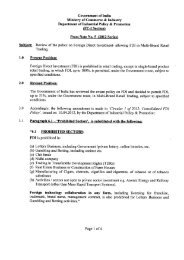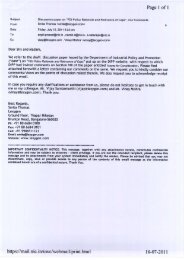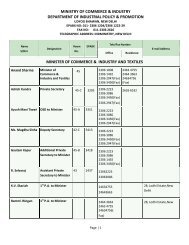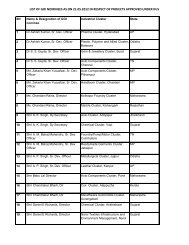fdi in india and its growth linkages - Department Of Industrial Policy ...
fdi in india and its growth linkages - Department Of Industrial Policy ...
fdi in india and its growth linkages - Department Of Industrial Policy ...
Create successful ePaper yourself
Turn your PDF publications into a flip-book with our unique Google optimized e-Paper software.
Chapter 7: Primary Survey:<br />
Analysis <strong>and</strong> Results<br />
7.1 Backdrop<br />
Even though most of the objectives of the study were fulfilled us<strong>in</strong>g secondary data <strong>in</strong> Chapter 6, a primary survey of<br />
FDI-enabled enterprises was undertaken to gather relevant <strong>in</strong>formation across India. Separate survey questionnaires<br />
were prepared for manufactur<strong>in</strong>g <strong>and</strong> service firms, 1 <strong>in</strong> order to capture all the relevant <strong>in</strong>formation perta<strong>in</strong><strong>in</strong>g to these<br />
sectors, <strong>and</strong> discussed with knowledgeable persons. Then, a survey was conducted to collect <strong>in</strong>formation from FDIenabled<br />
enterprises.<br />
To select samples for the primary survey, a list of FDI enterprises was compiled from company-level records provided<br />
by the <strong>Department</strong> of <strong>Industrial</strong> <strong>Policy</strong> <strong>and</strong> Promotion (DIPP), M<strong>in</strong>istry of Commerce <strong>and</strong> Industry, Government of<br />
India. These records conta<strong>in</strong> <strong>in</strong>formation on FDI <strong>in</strong>flows, <strong>in</strong>vest<strong>in</strong>g country, name of the company, NIC sector <strong>and</strong> item<br />
code. They are called company-specific records as these are entered as many times as a company receives foreign<br />
<strong>in</strong>vestment dur<strong>in</strong>g a particular year. Company records were available for the period January 2000 to June 2007. They<br />
were supplied <strong>in</strong> html format, which were converted <strong>in</strong>to Excel files for easy process<strong>in</strong>g <strong>and</strong> tabulation. After conversion,<br />
<strong>in</strong>dividual records were edited for the name of the company <strong>and</strong> sectors. This exercise facilitated group<strong>in</strong>g of companies<br />
by year, routes <strong>and</strong> sector. After clean<strong>in</strong>g <strong>and</strong> edit<strong>in</strong>g, a total of 20,420 processed records were obta<strong>in</strong>ed. These are spread<br />
across 92 sectors as classified under the Industries (Development <strong>and</strong> Regulation) Act (IDR Act), 1951.<br />
However, for sampl<strong>in</strong>g purposes the <strong>in</strong>dividual records of a company were merged to form unique companies. Records<br />
with an FDI <strong>in</strong>flow above $10,000 (0.01 million) were considered to prepare a list of unique companies. With this cutoff,<br />
the number of records came down to 14,850. It was found that records with <strong>in</strong>vestment below $0.01 million had<br />
entries with zero amount of FDI; these records were grouped separately <strong>and</strong> samples of unique companies were obta<strong>in</strong>ed<br />
from them. This would help assess the reasons for the low level of <strong>in</strong>vestment.<br />
The list of unique companies was prepared such that if a particular company had received foreign <strong>in</strong>vestment more than<br />
once <strong>in</strong> a specific sector dur<strong>in</strong>g January 2000 to June 2007 that particular company was made unique by that sector <strong>and</strong><br />
<strong>its</strong> cumulative FDI was calculated accord<strong>in</strong>gly. However, if the company had received foreign <strong>in</strong>vestment <strong>in</strong> different<br />
sectors, it was considered as a different company. Through this process, the records were merged <strong>in</strong>to 9,056 unique<br />
companies that accounted for cumulative foreign direct <strong>in</strong>vestment of $38.12 billion.<br />
The list of unique companies was used to select samples for the primary survey. A sample of about 20 per cent was<br />
selected <strong>and</strong> a two-stage sampl<strong>in</strong>g technique was followed to select samples. First, a weighted stratified sampl<strong>in</strong>g<br />
technique was applied. Under this method, unique companies were divided <strong>in</strong>to groups or strata, <strong>and</strong> samples were<br />
selected separately from each stratum. Here, sectors act as strata. Samples were selected from each stratum based on<br />
weights, where the weight was the average of the share of number of companies <strong>and</strong> share of FDI <strong>in</strong> each sector. This<br />
procedure is simple <strong>and</strong> takes <strong>in</strong>to account both the number of companies <strong>and</strong> amount of FDI <strong>in</strong> each sector, but it<br />
resulted <strong>in</strong> over-sampl<strong>in</strong>g of companies <strong>in</strong> a few sectors, because these sectors comprised a small number of companies<br />
but accounted for relatively high amounts of FDI, that is, the FDI per company was high. To overcome this problem,<br />
the over-sampled companies were redistributed to other sectors such that it did not exceed the total number of<br />
1. Copies of the questionnaires are provided at the end of the report.<br />
73












